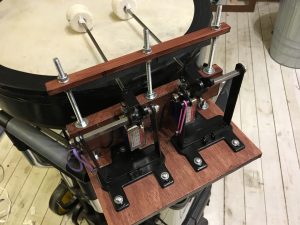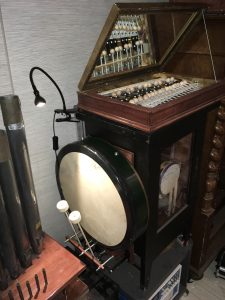
Ah, well. The percussion bass drum is pretty much finished (see earlier updates here and here). The solenoids are mounted, the drivers are tested and installed under the drum, and everything is ready. Unfortunately, the solenoids are not quite as strong and powerful, as I had hoped and, indeed, designed for. In the current mechanical configuration, they are not able to pull the mallets nearly as hard, as I had hoped. Some adjustments can be made to make them sound off consistently, but it’s certainly not going to be mistaken for thunder. I’m afraid we’ll have to make some other changes to the setup to better utilize the pulling force of the solenoids.

Some changes are quite easy, like pulling the pedal mounts a bit away from the solenoids. The setup is basically a class 3 lever, with the fulcrum (pivot) at one end, the resistance (mallet head) at the other end and the effort (solenoid) between the two endpoints. The solenoid has a stroke length of 10-15mm, so that’s a fixed measure. The closer the solenoid is to the fulcrum, the farther the mallet can be moved by the stroke length, but it also means it takes more effort (force) to move the mallet. By moving the pedal mounts (and thus also the fulcrum) back means that the solenoids will pull at the mallet arm further from the fulcrum, making better use of the force, though at a cost of moving distance. Some experiments must be made to determine, if we can reach a point where we get a bit more sound out of the drum.
If that doesn’t work, we are goin to have to look at the entire mechanical setup and perhaps discard the pedal mounts altogether and build something else.
Update:

What works is, as predicted, to move the pedal mounts a bit back, but combined with replacing the steel mallet rods with even longer wooden dowel rods. Using wood greatly reduces the torque (rotational force) needed to swing the mallet, while the extra length gives the mallet head more momentum as it hits the drum vellum.
So, a bit of reconstruction, but not much. The drum still won’t drown out a jet engine, but it will have to do. The bass has been mounted on the EnsembleBot cabinet, and now we need to calibrate the drum to determine how many milliseconds of solenoid actuation is needed, and then re-program the master controller to accept the newest member in the ensemble.